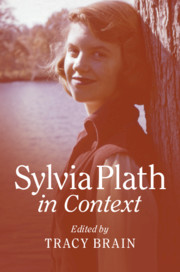Book contents
- Sylvia Plath in Context
- Sylvia Plath in Context
- Copyright page
- Contents
- Notes on Contributors
- Acknowledgements
- Chronology
- Abbreviations and Textual Note
- Key Archives
- Introduction
- Part I Literary Contexts
- Part II Literary Technique and Influence
- Part III Cultural Contexts
- Part IV Sexual and Gender Contexts
- Part V Political and Religious Contexts
- Part VI Biographical Contexts
- Part VII Plath and Place
- Part VIII The Creative Afterlife
- Chapter 31 An Alternative Afterlife: Plath’s Experimental Poetics
- Chapter 32 British and American Editions of Ariel and The Bell Jar
- Chapter 33 After Plath: The Legacy of Influence
- Chapter 34 P(l)athography: Plath and Her Biographers
- Bibliography
- Index
Chapter 32 - British and American Editions of Ariel and The Bell Jar
from Part VIII - The Creative Afterlife
Published online by Cambridge University Press: 03 August 2019
- Sylvia Plath in Context
- Sylvia Plath in Context
- Copyright page
- Contents
- Notes on Contributors
- Acknowledgements
- Chronology
- Abbreviations and Textual Note
- Key Archives
- Introduction
- Part I Literary Contexts
- Part II Literary Technique and Influence
- Part III Cultural Contexts
- Part IV Sexual and Gender Contexts
- Part V Political and Religious Contexts
- Part VI Biographical Contexts
- Part VII Plath and Place
- Part VIII The Creative Afterlife
- Chapter 31 An Alternative Afterlife: Plath’s Experimental Poetics
- Chapter 32 British and American Editions of Ariel and The Bell Jar
- Chapter 33 After Plath: The Legacy of Influence
- Chapter 34 P(l)athography: Plath and Her Biographers
- Bibliography
- Index
Summary
Elena Rebollo-Cortés examines how the material features of Sylvia Plath’s final two books have played a key role in establishing a critical framework for the interpretation of her texts and in defining her posthumous identity as a writer. In the context of the publishing history and the literary afterlife of Plath’s works, Rebollo-Cortés shows us how the figure of Plath has been presented to readers through the visual and textual packaging of key editions of Ariel and The Bell Jar. These key works have had a wide readership and large presence in the literary market. Their editions have therefore played a major role in the creation and perpetuation of Plath’s identification with a tragic figure. This concentration on books as historical and material objects presupposes that editions are (sometimes overlooked) vehicles of meaning, revealing, for example, that editions of Ariel disclose how Plath has been portrayed as a Faber poet, a woman poet, or a myth, while editions of The Bell Jar have privileged biographical readings of the novel.
Keywords
- Type
- Chapter
- Information
- Sylvia Plath in Context , pp. 340 - 349Publisher: Cambridge University PressPrint publication year: 2019

